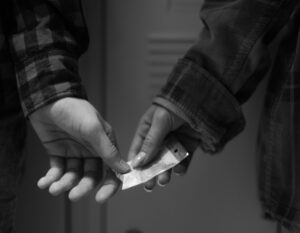
Here are a few juvenile crime statistics in Baltimore that solidify the notion that prevention programs are a necessity, no longer a luxury.
Juvenile arrests in Baltimore have been reduced by more than half
Baltimore city has seen a steady reduction in juvenile arrests each year for the last decade, with a 55% percent decrease between 2010 and 2019. Most of the juvenile crimes include property crimes and violent crimes, both of which are gradually plummeting since 2017.
Overall juvenile arrests across the country have fallen – a decline attributed in part to police departments’ efforts to focus on serious crime while avoiding enforcement actions against juveniles for less serious offenses.
There has been a conscious effort towards promoting correction over punishment, which may have been the reason for the declining juvenile arrest numbers.
Only 33% of juveniles are charged as adults

Youth who go through the juvenile system have the opportunity to be rehabilitated and have a better chance at becoming productive citizens than if they are sent through the adult criminal justice system.
This is why it’s critical for parents to understand juvenile law, so they can hire the right juvenile attorney to fight for their child and keep them out of the adult criminal justice system, lowering their exposure to other criminals in the process.
There has been a growing movement to make juvenile crime statistics public so that residents can understand the full scope of this problem. As a result, the number of juveniles being transferred back to the juvenile court after being charged as adults has increased from 19% to 67%.
In 2017, only 33% of the youth charged as adults appeared in the adult court; the rest were given a chance at correction. Juvenile defense lawyers can help ensure charged youth are given a chance at correction.
The average detention time for juvenile crimes is four to six months
From the time they are born until they reach adulthood, children undergo a significant amount of physical and emotional changes. Their ability to reason is greatly impaired and they often engage in impulsive behavior that is dangerous to themselves or others.
Therefore, it is society’s responsibility to give the youth a second chance and a safe space for correction and starting afresh. Juvenile curfews aren’t what stop crime, it’s a supportive community and a chance for beginning again.
For this reason, juveniles who are charged as adults are often detained for four months or more. Less than 25% of those charged as adults serve jail time or out-of-home confinement.
Working with a good juvenile attorney, who has experience dealing with similar juvenile cases, can increase your chance of avoiding jail time.
Racial disparity in juvenile arrests is still quite prominent

“During the original negotiations around the consent decree, it was apparent that there were gaps in the city’s juvenile diversion system,” says Ganesha Martin, Director of the Mayor’s Office of Criminal Justice.
Time and again, we have witnessed the juvenile crime law being unfair to minority groups. In fact, 90% out of the 64% of Baltimore’s African-American youth population is arrested for juvenile crimes even though most of these crimes are misdemeanors.
Violent crimes in Baltimore have been up since 2015
The juvenile law categorizes juvenile offenses into two types: violent crimes, which are comprised of murder and non-negligent manslaughter, forcible rape, robbery, and aggravated assault; and property crimes, which are comprised of burglary, larceny-theft, and motor vehicle theft.
Although property crimes have been going down since 2009, we have been seeing a rise in violent crimes since 2015 in Baltimore, MD. By 2018, the rates were up by as much as 37%, which is an alarming number that deserves our attention.
Misdemeanors and non-violent felonies have decreased significantly
Misdemeanors are less serious crimes than non-violent felonies, which are punishable by imprisonment of more than one year. While technically any criminal act can be considered a misdemeanor or a felony, in practice, the distinction is primarily important in two contexts: (1) whether the defendant will be tried in state or federal court and (2) how the offense will be punished.
According to the 2019 Baltimore crime report, misdemeanors have decreased by 85% while non-violent felonies have decreased by 79% in the past 10 years. Since the report isn’t segmented based on age or race, it is safe to conclude that these stats include the crimes committed by juveniles, as well.
4.7 per 1,000 youth are arrested for drug-related crimes

For example, teenagers often participate in recreational drug use. They usually do this because they are curious to experience new things and they want to socialize with their friends. They may start with the seemingly harmless marijuana and quickly escalate into heavier drug abuse, which may also lead to more serious crimes such as theft or even assault.
Fortunately, only 0.47% of youth arrests are categorized under drug-related crimes in Baltimore. But this number isn’t as reliable as it should be because most juvenile drug offenses never even come to light.
The juvenile justice system is not the most transparent
The juvenile justice system is designed to rehabilitate and reform those who commit crimes, rather than punish them. Treatment, counseling, education, and therapy are the primary methods used, rather than incarceration or prosecution. But we are long from establishing a fair and just system.
“Case outcomes for youth charged with violent crimes appear to be driven by a small number of individual judges in a process that is not very transparent,” reports Abell Foundation, an organization that works towards the enhancement of Baltimore’s community.
So, as long as the juvenile justice system will continue to deny justice, people will keep requiring the expertise of an experienced Baltimore juvenile lawyer on their case to get a shot at correction – something that every youth deserves. Parents can read our resources to learn more about juvenile crime, or they can contact Saller Law today for a free consult.
-
In every case, we work directly with clients from the beginning to the end of a case. We hear about many lawyers who take the money and their client interaction doesn’t take priority. We know that an ideal outcome must come from collaboration with our clients. This approach ensures that everybody gets a fair deal – that our clients are never run over by what can be an unfair system. If you have been charged or are being investigated, it is absolutely crucial to begin defending as soon as possible. We encourage you to get in touch.
Get Your Free Consult

